|
Following
Gandhi's Path - Part 5
In
Birla House with Gandhi
By Jan
Oberg
TFF director
The white, palatial house of the business dynasty,
Birla, stands just a couple of kilometres from Connought
Place, a well-known tourist attraction in the greenest
area of Delhi. This is the place where Gandhi spent the
last 144 dramatic days of his life. The museum in the
building reflects his life and death.
In the park, the visitor can follow the steps of his
last walk. From the door of the plain, white painted room
with a glass veranda where he lived there are cement
footprints across the park to where he was murdered. Here
the visitors go barefoot and silent.
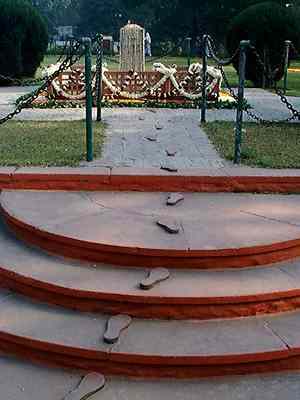
Photo Jan Öberg, © TFF
2001
Gandhi's last steps - Birla
House, Delhi
In the park, there are colossal trees with abundant
birdlife, a sea of flowers, vast lawns, sculptures and a
mural relief illustrating the history of India and the
achievements of Gandhi.
Birla House or "Gandhi Smriti" is an oasis, which is
run lovingly in the spirit of Gandhi. Its director, Dr
Neelakanta Radhakrishnan, is one of the few genuine
Gandhians in India. As the Birla House director, he is a
government official, but he is also researcher, activist,
writer and leader of the Japanese layman-Buddhist peace
organisation Soka Gakkai. Together with his wife he
manages an institute for non-violence in Kerala. He has
written books on Satyagraha, non-violence actions and
non-violence activists all around the world. This khadi
clad nomad is always on the move, in spite of his fragile
health.
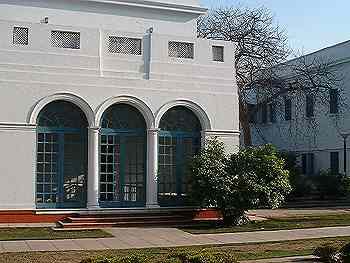
Photo Jan Öberg, © TFF
2001
Birla House, Gandhi's room is
behind the blue windows - this is where he lived and
where he died after the dramatic shots in the
garden
During his years as director he has mapped out
Gandhi's last 144 days in life, hour by hour, something
no one else had ever thought of doing before him.
"I don't belong to the mainstream Gandhians of this
country, whose different sects guard their own "one and
only true" interpretation of Gandhi and always without
question fight that of others. How can anyone try to
monopolize a person who was so aware of his own mistakes
and always ready to question himself? The elite of this
country probably has some respect for me as the head of
Birla. The prime minister is de facto my chairman of the
board, but considering that I take Gandhi seriously and
propagate his ideas wherever I can, I guess I am a little
bit dangerous," he says with laughter.
"The Congress Party knows only a vulgar version of
Gandhi's ideas. Remember that Gandhi's last publication
was about the dissolution of the Congress Party. He knew
that corruption would spread if all the power to govern
India was gathered in the hands of a little group. He
wanted to have a kind of People's Front. Those who came
after him were working in his spirit, indeed, but the
problem with them was that they had forgotten Gandhi's
constructive program. This is why there is no "buffer" or
any social space for dialogue between the elite and the
people in India".
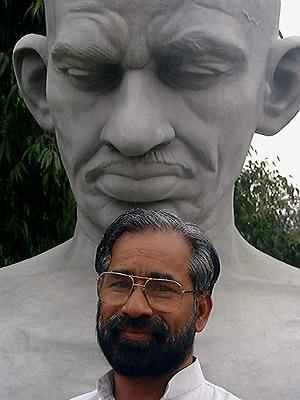
Photo Jan Öberg, © TFF
2001
Neelakanta Radhaskrishnan, Delhi
2001
Neelakanta Radhakrishnan continues:
"India was completely drained by the time it became
independent in 1947. We should have understood that this
was the start of India's own problems. Nehru was really a
visionary. He wanted to combine Russian-inspired
socialism with elements of India's own culture and
reality, as well as Gandhian philosophy. After all, it
was brilliant and perfectly right under the circumstances
of that time.
"Today, however, everything is subordinated to THE
MARKET. The only positive thing that happened is that the
panchayat-system was introduced in some of the member
states of the federation in 1995. It implies that every
village has its own citizens' council, which also have
meetings on municipal and higher levels. One third of
them must be women. This is quite in Gandhi's spirit:
grassroots democracy based on need, India built from
below, upon its 700,000 villages! But how long can a
country function with so much corruption and
corporativism at the top?"
"But," I ask him, "what do you think of globalisation?
What does it mean for India?"
"I look at it philosophically. During thousands of
years India had been visited or, properly speaking,
invaded by Greeks, Huns, Arabs, Mongols, Portuguese,
Frenchmen, other Christians, Muslims, British. Many other
countries would have let themselves be oppressed by the
technology and the military power. But not India, it
stands like a rock in this world. We have a cultural
variety that permits us to absorb some penetration and we
never fall. That's why today's globalisation is not a
larger challenge to India as a whole, but of course it
implies a certain amount of danger. Having said that,
let's not forget that Gandhi himself was a product of
globalisation. He was educated in London, lived in South
Africa and was inspired by all kinds of religions and
westerners like Jesus, Tolstoy, Thoreau and Ruskin".
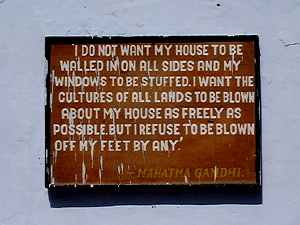
Photo Jan Öberg, © TFF
2001
Plaque on the wall of the
Sabarmati ashram, Ahmedabad 2001
It makes me think of how Gandhi himself expressed the
same thing, as can be seen on the wall of his ashram at
Ahmedabad:
"I do not want my house to be walled in on
all sides and my windows to be stuffed. I want the
cultures of all lands to be blown about my house as
freely as possible, but I refuse to be blown off my
feet by any".
Unity in variety is an Indian ideal. Gandhi's words
are pertinent to the current immigration debate. I would
like to have it spread to all parts of the former
Yugoslavia where the EU and NATO blow down as much as
they can and to other conflict zones where those who are
"different" are maltreated.
I tell Radhakrishnan that I shall travel through India
in the footsteps of Gandhi. It makes him very glad.
"When you come back I wish to invite you to spend a
couple of days in the guest room at Birla House. You can
come and go as you wish, sit there early in the morning
or late in the night. You will discover that there is
quite a special atmosphere here".
No sooner said than done. He was perfectly right. I
remember my three days and moonlit nights near Gandhi's
life and death with deep gratitude.
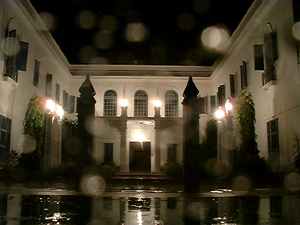
Photo Jan Öberg, © TFF
2001
Birla House on a rainy night,
Delhi
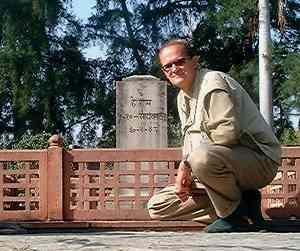
Photo Jan Öberg, © TFF
2001
The author at the Gandhi
memorial in Birla Garden
Translated by Alice
Moncada
Translation edited by Sara E. Ellis
Other
articles about India, "Following Gandhi's Path" and
picture galleries
©
TFF 2002

Tell a friend about this article
Send to:
From:
Message and your name
|